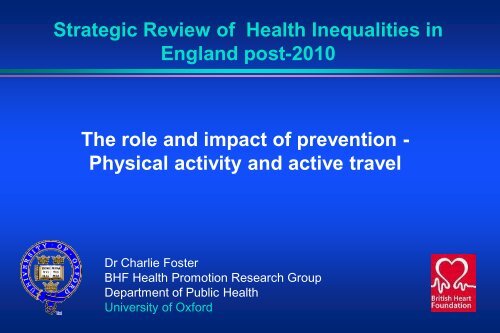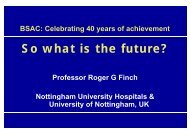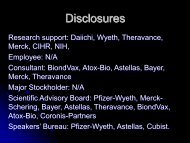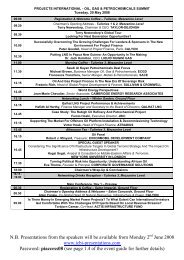Physical activity and active travel
Physical activity and active travel
Physical activity and active travel
Create successful ePaper yourself
Turn your PDF publications into a flip-book with our unique Google optimized e-Paper software.
Strategic Review of Health Inequalities in<br />
Engl<strong>and</strong> post-2010<br />
The role <strong>and</strong> impact of prevention -<br />
<strong>Physical</strong> <strong>activity</strong> <strong>and</strong> <strong>active</strong> <strong>travel</strong><br />
Dr Charlie Foster<br />
BHF Health Promotion Research Group<br />
Department of Public Health<br />
University of Oxford
Presentation Objectives<br />
• To describe the case for physical <strong>activity</strong> <strong>and</strong> <strong>active</strong> <strong>travel</strong><br />
• To assess their relationship with inequalities<br />
• To present examples of successful <strong>active</strong> <strong>travel</strong><br />
interventions
First clinical episodes* of CHD in male central<br />
London bus drivers <strong>and</strong> conductors aged 35-<br />
64, 1949-1950<br />
No. of<br />
cases<br />
Age st<strong>and</strong>ardised Rate<br />
per 1000 p.a.<br />
Drivers 80 2.7<br />
Conductors 31 1.9<br />
*Angina, MI, CHD mortality<br />
Morris et al, Lancet 1953
<strong>Physical</strong><br />
<strong>activity</strong>
<strong>Physical</strong><br />
<strong>activity</strong>
<strong>Physical</strong><br />
<strong>activity</strong>
<strong>Physical</strong><br />
<strong>activity</strong>
Leisure<br />
Work<br />
<strong>Physical</strong><br />
<strong>activity</strong><br />
Exercise & Sport<br />
Active Travel<br />
Household
61% of men <strong>and</strong> 71% of women do not meet the Chief Medical<br />
Officer’s minimum recommendations for physical <strong>activity</strong> in adults<br />
% <strong>active</strong><br />
Men<br />
Women<br />
Age
% <strong>active</strong><br />
Age
% <strong>active</strong><br />
Age
% <strong>active</strong><br />
Age
% <strong>active</strong><br />
Age
% <strong>active</strong><br />
Age
% <strong>active</strong><br />
Age
<strong>Physical</strong> <strong>activity</strong>, <strong>active</strong> <strong>travel</strong> <strong>and</strong> inequalities<br />
• <strong>Physical</strong> <strong>activity</strong> choices are socially patterned
Hours per week<br />
Mean hours per week of brisk/fast pace walking<br />
in Scotl<strong>and</strong> <strong>and</strong> Engl<strong>and</strong> by social class<br />
2.5<br />
2.0<br />
1.5<br />
1.0<br />
Scottish Women<br />
Scottish Men<br />
English Women<br />
English Men<br />
0.5<br />
0.0<br />
I & II III NonManual III Manual IV & V<br />
Dr Melvyn Hillsdon – University of Exeter
Walking trips, for transport, per person per year<br />
by household income<br />
Lowest real<br />
income<br />
Second<br />
level<br />
Third<br />
level<br />
Fourth<br />
level<br />
Highest real<br />
income<br />
Walk 307 275 239 218 208<br />
Car 224 325 458 537 602<br />
National Travel Survey, 2006<br />
Dr Melvyn Hillsdon – University of Exeter
<strong>Physical</strong> <strong>activity</strong>, <strong>active</strong> <strong>travel</strong> <strong>and</strong> inequalities<br />
• <strong>Physical</strong> <strong>activity</strong> choices are socially patterned<br />
• Individual approaches to promote physical <strong>activity</strong> have the<br />
potential to increase inequalities<br />
• Availability of physical <strong>activity</strong> facilities declines with level of<br />
area deprivation
Availability of physical <strong>activity</strong> facilities declines with<br />
level of area deprivation<br />
The density of exercise<br />
facilities by quintile of<br />
deprivation for the<br />
county of Kent in<br />
Southeast Engl<strong>and</strong>
<strong>Physical</strong> <strong>activity</strong>, <strong>active</strong> <strong>travel</strong> <strong>and</strong> inequalities<br />
• <strong>Physical</strong> <strong>activity</strong> choices are socially patterned<br />
• Individual approaches to promote physical <strong>activity</strong> have the<br />
potential to increase inequalities<br />
• Availability of physical <strong>activity</strong> facilities declines with level of<br />
area deprivation<br />
• Active <strong>travel</strong> interventions must contain environmental<br />
supports to sustain individual choice (i.e. public transport)
Policies<br />
Places<br />
People
Bruno Taylor's Playful Spaces
Right-h<strong>and</strong> turn lanes
Right of way over motorists
Linked traffic light system
Priority of bicycle lanes
Using the environment to promote <strong>active</strong> living<br />
• Successful <strong>active</strong> <strong>travel</strong> interventions blend changes to<br />
places, people <strong>and</strong> policies<br />
• European examples demonstrate what can be achieved<br />
in the long term<br />
• NICE <strong>Physical</strong> <strong>activity</strong> <strong>and</strong> Environment public health<br />
guidance offers direction
The Cycling Demonstration<br />
Towns programme<br />
• First phase: October 2005 –<br />
October 2008<br />
• All towns funded at approx<br />
£5 per head per year,<br />
matched by the local<br />
authority<br />
• Comprehensive evaluation
Annual growth rates: European cities <strong>and</strong> CDTs<br />
City<br />
Annual<br />
increase in<br />
cycling flows<br />
Darlington +14.2%<br />
Exeter +9.9%<br />
Brighton & Hove +9.0%<br />
Strasbourg +7.0%<br />
Lanc w Morecambe +6.2%<br />
Vienna +6.4%<br />
Graz +5.9%<br />
Munich +5.5%<br />
Hanover +5.4%<br />
City<br />
Annual<br />
increase in<br />
cycling flows<br />
Nottingham +4.8%<br />
Freiburg +4.4%<br />
Munster +3.6%<br />
Aylesbury +3.6%<br />
Berlin +3.2%<br />
Derby +2.5%<br />
Zurich +2.3%<br />
Delft +1.2%<br />
Adapted from: Transport for London (2004) ‘Creating a chain reaction. The London Cycling Action Plan. February 2004.<br />
(http://www.croydon-lcc.org.uk/downloads/2004_TfL_LondonCyclingActionPlan.pdf)
Summary<br />
• <strong>Physical</strong> <strong>activity</strong> <strong>and</strong> <strong>active</strong> <strong>travel</strong> promotion are part of complex<br />
system approaches not isolated as single dose solutions<br />
• Synergies with economic regeneration, crime, welfare <strong>and</strong> climate<br />
change<br />
• We need high level strategic <strong>and</strong> political commitment, consistent<br />
implementation of best practice <strong>and</strong> targeted investment
Strategic Review of Health Inequalities in Engl<strong>and</strong> post-2010<br />
Thanks<br />
Nick Cavill – Cycle Engl<strong>and</strong><br />
Dr Melvyn Hillsdon – University of Exeter<br />
Dr Adrian Davis - Bristol City Council<br />
Phil Insall - Sustrans<br />
charlie.foster@dphpc.ox.ac.uk








